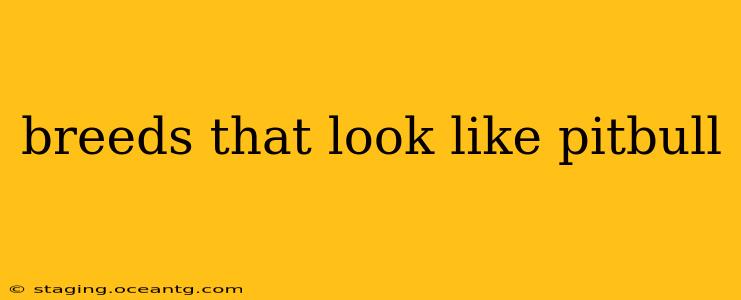Many breeds share similar physical characteristics with Pit Bulls, leading to frequent misidentification. This can be problematic, as Pit Bulls are often subject to breed-specific legislation. Understanding the visual similarities and key differences is crucial for responsible pet ownership and accurate breed identification. This article will explore breeds often mistaken for Pit Bulls, highlighting their distinct traits and dispelling common misconceptions.
What Defines a "Pit Bull" Appearance?
Before diving into similar breeds, it's important to clarify what constitutes a "Pit Bull" appearance. The term "Pit Bull" is not a breed itself but rather a colloquial term often used to encompass several breeds with similar physical characteristics. These breeds, including the American Pit Bull Terrier, American Staffordshire Terrier, Staffordshire Bull Terrier, and sometimes even the American Bully, share traits like:
- Muscular build: A stocky, powerfully built body with well-developed muscles.
- Broad head: A relatively large head with a wide skull and powerful jaw.
- Short coat: A smooth, short coat that is easy to maintain.
- Variety of colors and markings: These breeds can come in a wide range of colors and patterns, including brindle, fawn, white, black, and combinations thereof.
Breeds Often Mistaken for Pit Bulls
Several breeds share some physical similarities with Pit Bulls, leading to confusion. Let's examine some of these:
1. American Bulldog
American Bulldogs, while sharing a muscular build and broad head with Pit Bulls, are generally larger and heavier. They often have looser skin and a more pronounced jowl. Their overall appearance is less refined than that of some Pit Bull breeds.
2. Bull Terrier
Bull Terriers possess a distinctive, egg-shaped head that sets them apart from Pit Bulls. While they are muscular, their body type is leaner, and their overall build is less bulky. Their coat can be short or wiry, depending on the variety.
3. Boxer
Boxers, with their distinctive brindle coat and square muzzle, sometimes get mistaken for Pit Bulls, particularly if the Boxer is particularly muscular. However, Boxers have a more refined head shape and a longer, more elegant gait than Pit Bulls.
4. Other Mastiff Breeds
Some larger mastiff breeds, with their powerful musculature and broad heads, can appear similar to Pit Bulls from a distance. However, their size is a key differentiator, as these breeds are typically significantly larger than Pit Bulls.
How to Tell the Difference: Key Distinguishing Features
While several breeds may share some superficial similarities, there are key differences that allow for accurate identification. Careful observation of the following features can help distinguish between breeds:
- Head shape: Pay close attention to the skull shape, muzzle length, and jawline.
- Body proportion: Note the dog's overall build, considering the relationship between height and weight.
- Coat texture and length: Examine the coat for texture, length, and any distinctive markings.
- Gait and movement: Observe how the dog moves, noting its stride and posture.
Is it Really a Pit Bull? The Importance of Accurate Identification
Correctly identifying a dog's breed is important for various reasons, including accurate breed-specific health screening, responsible breeding, and compliance with breed-specific legislation. If you are unsure about a dog's breed, seeking the opinion of a professional, such as a veterinarian or experienced dog breeder, is always advisable.
Frequently Asked Questions (FAQ)
What breeds are often mistaken for Pit Bulls?
Many breeds, including American Bulldogs, Bull Terriers, Boxers, and some mastiff breeds, share similar physical characteristics with Pit Bulls, leading to frequent misidentification.
How can I tell the difference between a Pit Bull and other similar breeds?
Key distinguishing features include head shape, body proportion, coat texture, and gait. Paying close attention to these details will help differentiate between breeds.
Why is accurate Pit Bull identification important?
Accurate identification is essential for responsible breeding, breed-specific health concerns, and compliance with breed-specific legislation.
This article provides a general overview, and individual dogs may vary within their breed. Always rely on multiple characteristics for accurate identification. Remember, responsible ownership includes understanding your dog’s breed and its specific needs.
